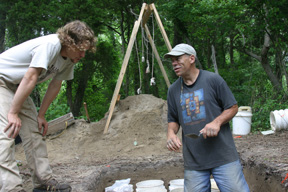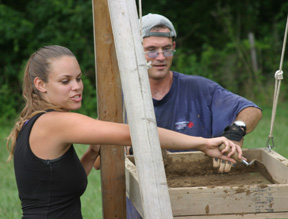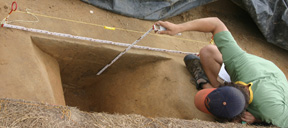Werowocomoco 2005 More than treasure uncovered during field school
 Knee deep in a perfectly rectangular hole,
bandana-clad William and Mary sophomore Julia Elkin flings shovelfuls
of rich, dark dirt into a suspended sifting box. Hardly a clump misses
its target, and as each pile of dirt arrives, Elkin’s fellow workers
shake and sift the soil through a screen. They coax uncooperative
chunks through the sifter with troughs and probe anxiously, hoping to
catch an artifact that will uncover some piece of the history they hope
to help reassemble.
Knee deep in a perfectly rectangular hole,
bandana-clad William and Mary sophomore Julia Elkin flings shovelfuls
of rich, dark dirt into a suspended sifting box. Hardly a clump misses
its target, and as each pile of dirt arrives, Elkin’s fellow workers
shake and sift the soil through a screen. They coax uncooperative
chunks through the sifter with troughs and probe anxiously, hoping to
catch an artifact that will uncover some piece of the history they hope
to help reassemble.
Werowocomoco, the primary residence of Chief Powhatan and the site Elkin and 16 other students are excavating as part of a William and Mary archeology field school, is rich with Native American and colonial artifacts. For the past three years, anthropology professor Martin Gallivan and his field schools have continued to uncover abundant evidence indicating that the site, sprawling nearly 30 acres along the York River in Gloucester, Va., was home to one of the most storied Native American communities in history.
Ongoing investigations have discovered Native American and European artifacts in numbers that correspond with a substantial village settlement dating to the early colonial period. These archaeological deposits, combined with descriptions of Werowocomoco by several Jamestown colonists, led the archaeologists to hypothesize that this site is the central village of the Powhatan chiefdom.
But it has not been physical artifacts that prove most revealing, though there are plenty. Pottery, ceramics, charcoal, projectile points and even musket balls continue to emerge, shedding light on the native community’s history as well as the contact period between the Indians and colonial settlers. As Elkin said, the research at Werowocomoco is different from other sites.
“A lot of sites sound more like treasure hunts or something,” she said.
Instead, it has been the native land features, uncovered below the plow zone throughout the entire site, that have provided the most insight into the historic Native American village.
“We’re getting these very big ditch features that we think date to around 1400, 1500 and 1600, probably dug a couple of hundred years before the contact period and lasted through the contact period,” Gallivan said. “We think they are essentially separating the residential core of the village from an elite or sacred space. What’s new isn’t that interpretation, but the extent of them—over 500 feet.”
Rectangular units peppered throughout the open fields of the site fit well within this hypothesis. Nestled deep at the back of the site, away from the river bank, a series of excavation units has begun to reveal even more.
“We’ve found what looks like a series of post holes that is either a large house, a palisade, or some sort of special use architecture,” Gallivan said. “This area of the site is just different. We’re not finding as many artifacts—we’re finding some—but we’re finding some unusual features.
“I think that’s a contribution we’re making. Most sites would spend their time on the river bank, but what we’ve realized is that the best way to understand these communities is to really take in a much broader area—a bigger part of the landscape.”


Near the river bank, artifacts abound. Though erosion has destroyed some of the site at the steep edges on the river, much still remains. Excavations near the water have produced some particularly fruitful areas.
“We had other units, farther back, but they were all plowed to hell. But we found a sealed in area that’s been not completely unexpected, but still nice to see. We’ve started pulling out this living area with big ceramic shards that are good for diagnostics and can tell us about time periods,” said William and Mary graduate student Brendan Burke.
Burke has worked closely with staff member Jeff Brown during the excavation. Brown, a Pamunkey Indian, has brought a unique perspective to the dig.
“Very few archeologists, especially in Virginia, have had the benefit of working with the native community directly on the ground. Consultation is one thing, but actually working with another student of archeology has been fantastic,” Burke said. “It’s interesting to work with someone who has a sincere, vested interest in the site. We all have personal or research interests, but to see someone who has a deep-rooted interest in it is very good.”
Brown, a waterman by occupation, has enjoyed the archeology so much that he is considering a career switch down the road. Amidst the flaked points, shell tempered and fabric impressed ceramics and complete projectile points, Brown also made another precious discovery along the bank of the York River that illustrates what it is that made Werowocomoco so special—an eagle feather.
“We had this beautiful site where eagles just come and land on old dead trees. I had an eagle feather I found 10 years ago which I had beaded and I wear with regalia. I found this other and it looks like it came from the same bird—and when you find them, it’s the day of the drop. They don’t last long because bugs eat them. That was really special,” Brown said.
Brown is also joined by his cousin, Ashley Atkins, a rising junior at James Madison University. Atkins, also a Pamunkey Indian, arrived at the site by coincidence.
“I am interning at the Department of Historic Resources in Richmond (a partner of the Werowocomoco research project), and they set me up with this opportunity. So I guess you could say it was fate that I ended up here,” Atkins said.
Even before the announcement of the site, researchers at Werowocomoco had collaborated with the native community every step of the way. Both Atkins and Brown said the relationship between the research group and the native community has been mutually beneficial.
“It’s a good group of people out here,” Brown said. “They seem to be very caring about the native way of life and about the artifacts that are found.”
“I think we need to have more Native Americans really getting involved because they need to learn about their heritage too,” Atkins said. “For me, what I’m getting out of it is that I’m really learning in depth about my background, my history, my culture, and about my family and other Virginia Indians—learning more and more about how my ancestors lived every day before the Europeans came.”
The research is important to everyone, Atkins said. Beyond the Werowocmoco research project, some tensions still exists between archeologists and the native communities, particularly in Virginia. But the work still needs to be done, Atkins said.
“I can see both sides, where the natives don’t want random people digging things up because it’s their history, and the archeological value because it is history. I think it belongs to all of us—it’s a history before American history, and it belongs to all of us, not one particular group,” she said.














